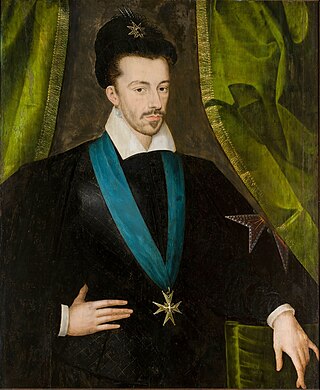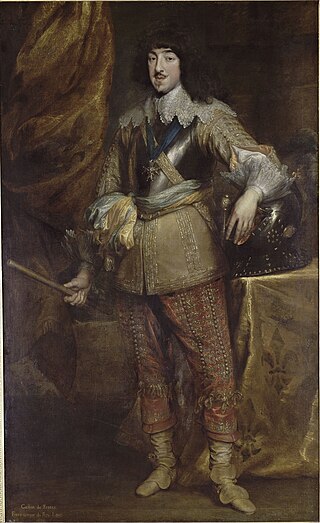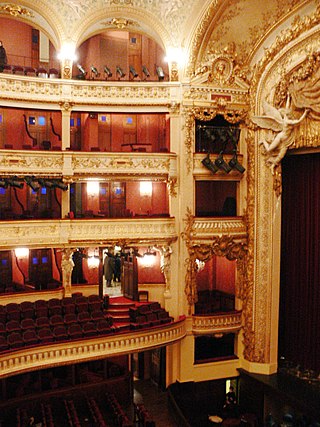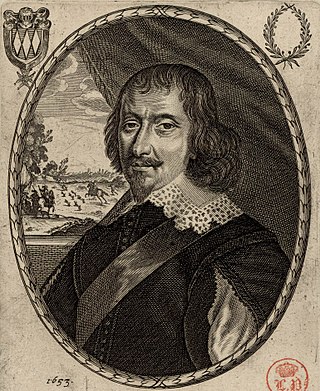| |||||
| Decades: | |||||
|---|---|---|---|---|---|
| See also: | Other events of 1581 History of France • Timeline • Years | ||||
Events from the year 1581 in France
| |||||
| Decades: | |||||
|---|---|---|---|---|---|
| See also: | Other events of 1581 History of France • Timeline • Years | ||||
Events from the year 1581 in France


1581 (MDLXXXI) was a common year starting on Sunday in the Julian calendar, and a common year starting on Thursday in the Proleptic Gregorian calendar.

Catherine de' Medici was an Italian (Florentine) noblewoman born into the Medici family. She was Queen of France from 1547 to 1559 by marriage to King Henry II and the mother of French kings Francis II, Charles IX, and Henry III. The years during which her sons reigned have been called "the age of Catherine de' Medici" since she had extensive, albeit at times varying, influence on the political life of France.

Henry III was King of France from 1574 until his assassination in 1589, as well as King of Poland and Grand Duke of Lithuania from 1573 to 1575.
This article contains information about the literary events and publications of 1639.

MonsieurGaston, Duke of Orléans, was the third son of King Henry IV of France and his second wife, Marie de' Medici. As a son of the king, he was born a Fils de France. He later acquired the title Duke of Orléans, by which he was generally known during his adulthood. As the eldest surviving brother of King Louis XIII, he was known at court by the traditional honorific Monsieur.

The Opéra-Comique is a Paris opera company which was founded around 1714 by some of the popular theatres of the Parisian fairs. In 1762 the company was merged with – and for a time took the name of – its chief rival, the Comédie-Italienne at the Hôtel de Bourgogne. It was also called the Théâtre-Italien up to about 1793, when it again became most commonly known as the Opéra-Comique. Today the company's official name is Théâtre national de l'Opéra-Comique, and its theatre, with a capacity of around 1,248 seats, sometimes referred to as the Salle Favart, is located at Place Boïeldieu in the 2nd arrondissement of Paris, not far from the Palais Garnier, one of the theatres of the Paris Opéra. The musicians and others associated with the Opéra-Comique have made important contributions to operatic history and tradition in France and to French opera. Its current mission is to reconnect with its history and discover its unique repertoire to ensure production and dissemination of operas for the wider public. Mainstays of the repertory at the Opéra-Comique during its history have included the following works which have each been performed more than 1,000 times by the company: Cavalleria Rusticana, Le chalet, La dame blanche, Le domino noir, La fille du régiment, Lakmé, Manon, Mignon, Les noces de Jeannette, Le pré aux clercs, Tosca, La bohème, Werther and Carmen, the last having been performed more than 2,500 times.

Claude Bouthillier, Sieur de Fouilletourte was a French statesman and diplomat. He held a number of offices, including Secretary of State and Superintendent of Finances, and distinguished himself in diplomacy throughout the 1630s, particularly in respect to France's entry into the Thirty Years' War.

The Paris Opera is the primary opera and ballet company of France. It was founded in 1669 by Louis XIV as the Académie d'Opéra, and shortly thereafter was placed under the leadership of Jean-Baptiste Lully and officially renamed the Académie Royale de Musique, but continued to be known more simply as the Opéra. Classical ballet as it is known today arose within the Paris Opera as the Paris Opera Ballet and has remained an integral and important part of the company. Currently called the Opéra national de Paris, it mainly produces operas at its modern 2,723-seat theatre Opéra Bastille which opened in 1989, and ballets and some classical operas at the older 1,979-seat Palais Garnier which opened in 1875. Small scale and contemporary works are also staged in the 500-seat Amphitheatre under the Opéra Bastille.

The Salle Le Peletier or Lepeletier was the home of the Paris Opera from 1821 until the building was destroyed by fire in 1873. The theatre was designed and constructed by the architect François Debret on the site of the garden of the Hôtel de Choiseul on the rue Lepeletier. Due to the many changes in government and management during the theatre's existence, it had a number of different official names, the most important of which were: Théâtre de l'Académie Royale de Musique (1821–1848), Opéra-Théâtre de la Nation (1848–1850), Théâtre de l'Académie Nationale de Musique (1850–1852), Théâtre de l'Académie Impériale de Musique (1852–1854), Théâtre Impérial de l'Opéra (1854–1870), and Théâtre National de l'Opéra (1870–1873).

The Ballet Comique de la Reine was an elaborate court spectacle performed on October 15, 1581, during the reign of Henry III of France, in the large hall of the Hôtel de Bourbon, adjacent to the Louvre Palace in Paris. It is often referred to as the first ballet de cour.

Balthasar de Beaujoyeulx, originally Baldassare daBelgiojoso was an Italian violinist, composer, and choreographer.

Margaret of Valois, popularly known as La Reine Margot, was Queen of Navarre from 1572 to 1599 and Queen of France from 1589 to 1599 as the consort of Henry IV of France and III of Navarre.
Le déserteur is a drame mélé de musique by the French composer Pierre-Alexandre Monsigny with a libretto by Michel-Jean Sedaine. It was first performed on 6 March 1769 by the Comédie-Italienne at their public theatre, the Hôtel de Bourgogne in Paris.

Claude Catherine de Clermont-Tonnerre de Vivonne, lady of Dampierre, countess and duchess of Retz, was a French courtier, writer, and salon host.

The Hôtel du Petit-Bourbon, a former Parisian town house of the royal House of Bourbon, was located on the right bank of the Seine on the rue d'Autriche, between the Louvre to the west and the Church of Saint-Germain l'Auxerrois to the east. It was constructed in the 14th century, not long after the Capetian kings of France enlarged the fortress of the Louvre in order to use it as a royal residence. On two 1550 maps it is shown simply as the Hôtel de Bourbon, but by 1652, as the Petit-Bourbon on the map of Gomboust. The Bourbons took control of France in 1589, at which time they also acquired the Louvre.

Violante Doria, also known as Yolande or Yolante, was an Italian soprano from Genoa. She was considered to be one of “the most successful musicians in France during the reigns of the last Valois kings.” She was married to bass singer Girard de Beaulieu who was a well-known and important singer of the royal court from as early as 1572 until the last year of his life in 1590.” The couple played a large role in the creation of the French ballet de cour, the Balet comique de la royne, in 1581. The successful careers of both Doria and her husband were an important part of structuring the music of the royal court and show the significance in the rise of chamber music.
Events from the year 1602 in France
Events from the year 1762 in France
Events from the year 1643 in France
Events from the year 1593 in France